Family : Strelitziaceae

Text © Prof. Pietro Pavone

English translation by Mario Beltramini
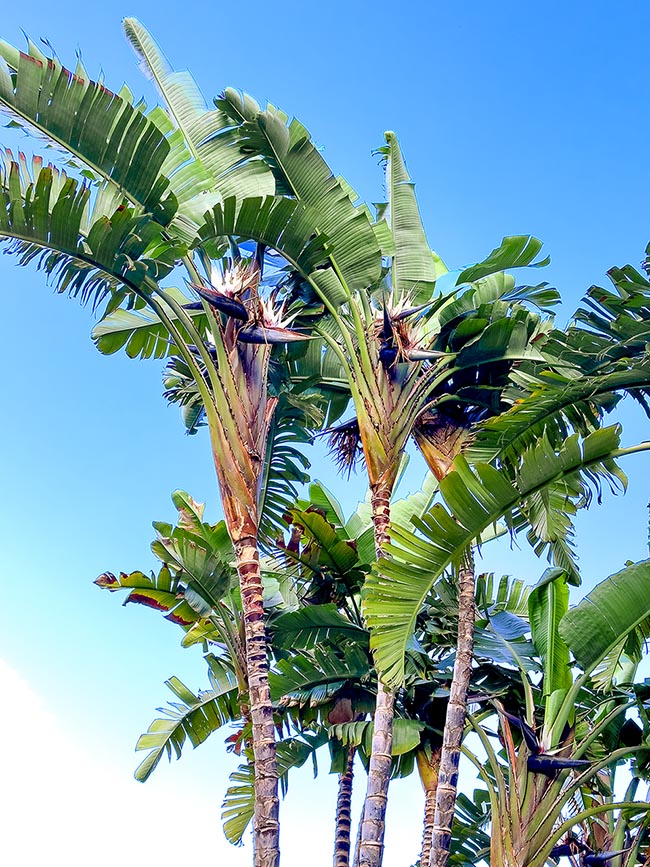
Strelitzia nicolai is a south-east African perennial evergreen reaching with dense tufts 5-12 m of height © G.Mazza
Strelitzia is a genus of monocotyledonous herbaceous plants belonging to the family Strelitziaceae, order Zingiberales, native to austral Africa.
The name Strelitzia is due to Joseph Banks (1743-1820), English botanist, long-time president of the Royal Society, who wanted to dedicate the name to Sophia Charlotte of Mecklenburg-Strelitz (1744-1818), wife of George III (1760-1801) King of Great Britain and Ireland. Banks, thanks to his significant financial availability, has financed botanical explorers for collecting plants all over the world. As a matter of fact, it is hypothesized that he had introduced in England, with the help of King George III, about 30.000 specimens of exotic plants, as live specimens as well as in the form of seeds, but also as dried samples and drawings, describing more than 1400 species new for the Science.
Strelitzia nicolai Regel & Körn. is found among the vegetation of the dunes and in the evergreen forests close to the south-eastern coast of Africa (Botswana, Kwa-Zulu-Natal, Mozambique, Zimbabwe).
The common name of the genus Strelitzia is “flower of the bird of paradise”, in southern Africa “crane flower”. The species is vulgarly called “giant white bird of paradise” or “wild banana of Natal”. At times it is also called “isigude”, “igceba”, “inkamanga”.
Strelitzia reginae was the first species of the genus to be introduced by Banks in Europe, in the Kew Royal Botanic Gardens in 1773. In 1789 flourished, arousing, because of the beauty of the inflorescences and of the flowers, great admiration particularly by the floriculturists of the time.
Also in the Imperial St. Petersburg Botanical Garden were present specimens of Strelitzia but of another species known with the name that Carl Peter Thunberg (1743-1828), in 1792, had called Strelitzia augusta, nowadays synonym of Strelitzia alba (L.f.) Skeels (1792). In the middle of the XIX century these specimens cultivated in the Garden had reached a height of 8 metres with a trunk approximately 6 metres high. But, at the time of flowering they proved to be different from each other. In fact, in some of them, besides the beauty of the posture and of the leaves, added also the beauty of the inflorescences with violet spathes, from which emerged the flowers with white outer tepals (sepals) and inner blue petals.
These magnificent blooms were observed by two German botanists: Eduard August von Regel (1815-1892) and Friedrich August Körnicke, (1828-1908). Regel from 1875 was the director of the Garden, arriving in St. Petersburg after a vast experience in other botanical gardens (Göttingen Garden, Bonn Garden, Berlin Garden and Zürich Garden).
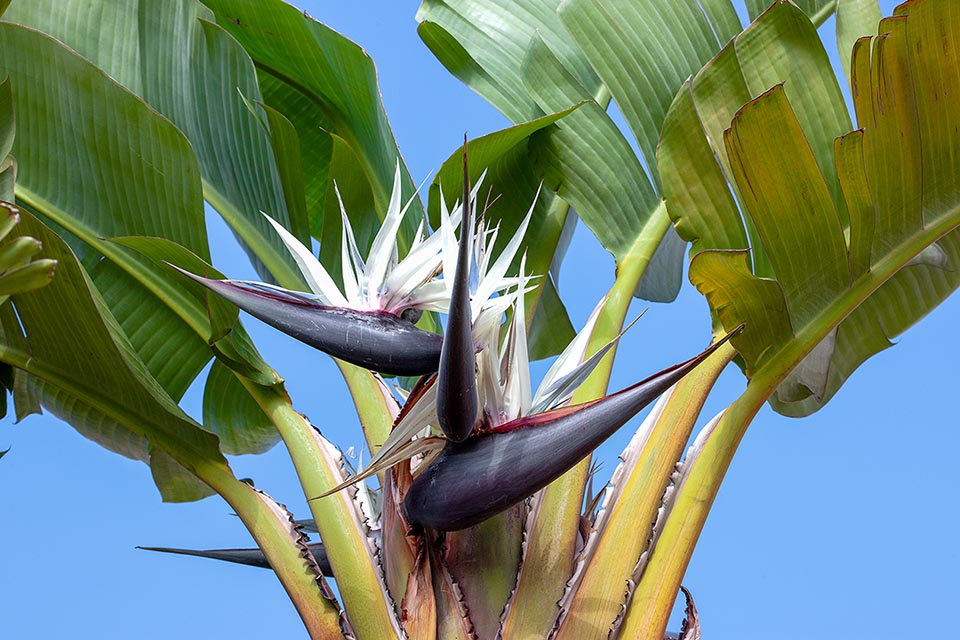
Like a banana tree with showy flowers, was the first species of genus Strelitzia introduced in Europe in 1773 at Kew Royal Garden © Giuseppe Mazza
Körnicke was the curator of the herbarium at the botanical gardens in St. Petersburg, and then became, in Bonn, professor in botany at the Agricultural Academy of Poppelsdorf.
The two botanists considered these specimens to belong to a new species they described in the magazine Gartenflora 7:265 (1858), in German language, and that was called Strelitzia nicolai in honour of the Grand Duke Nikolaj Nikolaevič Romanov (1856-1929), High Protector of the Russian Agricultural Association of St. Petersburg. It is very likely that, during a shipment of plants from southern Africa, this particular blooming may have escaped the collectors’ notice. In fact, they called with the name of Strelitzia augusta all the specimens they had collected and sent.
Strelitzia nicolai is a perennial plant, evergreen, similar to a banana-like plant, with multiple trunks forming dense tufts, 5-12 m tall, woody in the adult plants, formed by the foliar petioles after the detachment of the leaves.
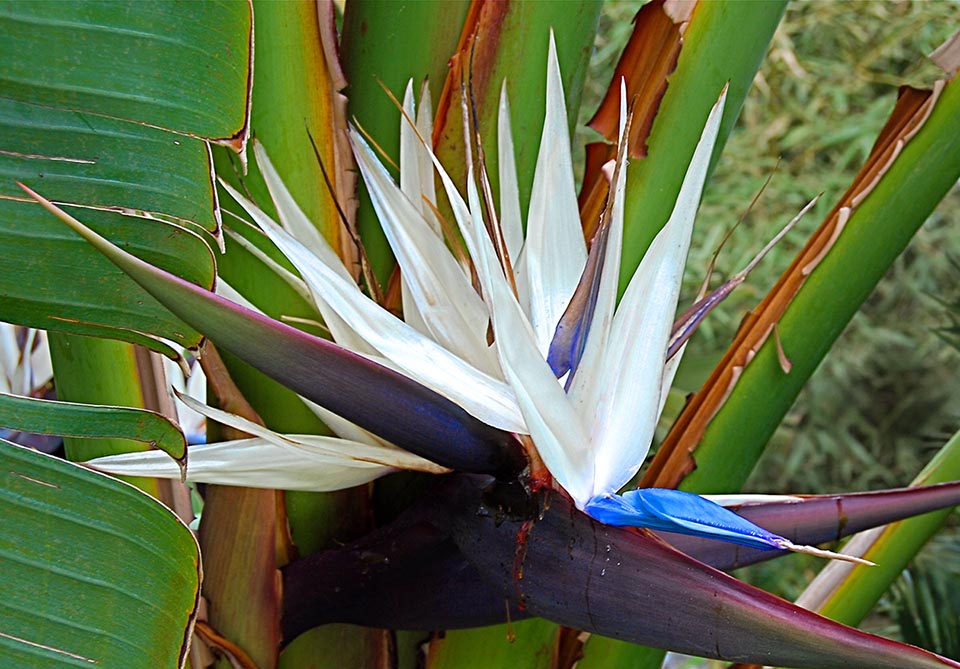
Flowers, with outer white sepals have a showy blue petal enclosing the anthers and the styles and raises to vertical in 2 days marking abundance of nectar © Robert Combes
The leaves, arranged in a fan shape on top of the trunks, have an about 150 x 60 cm oblong to ovate lamina, of glossy grey green colour, usually rounded at the base or rarely cordate, carried by long petioles. The central rib is quite evident and the secondary ones, going up to the foliar margin, are numerous and parallel.
The flowering occurs all year round, mostly in spring-summer. From the axils of the leaves get out 2-3 inflorescences that last 4-5 months. Each one is formed by a spathe inside which the flowers form. In total, each inflorescence produces about 20-30 flowers.
The largest number of flowers (10-12) is formed in the lower spathe whilst in the others the number of flowers reduces by 20-30% and often some flowers remain inside without going out. The spathes have a navicular shape and are big (about 45 cm), waxy, coriaceous, usually horizontal, of bluish colour with red shades.
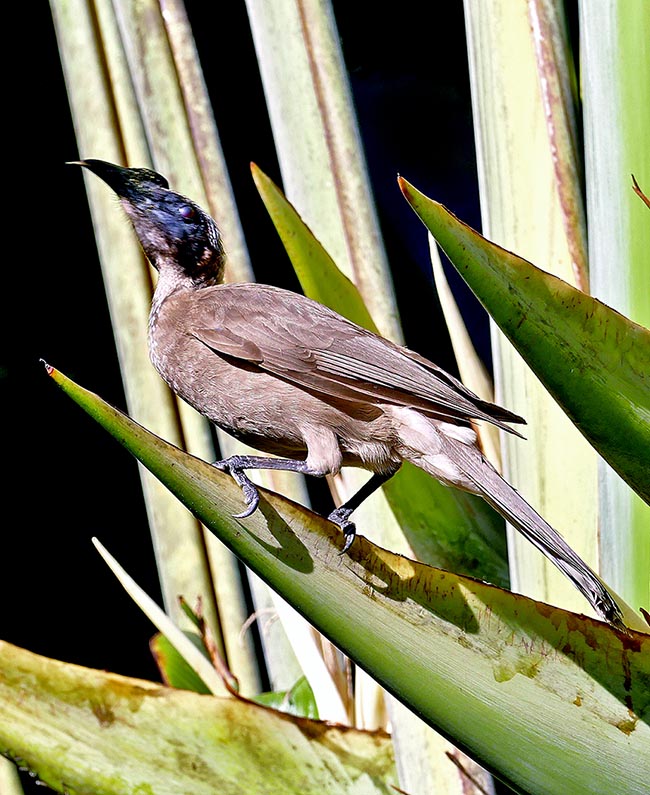
The birds fond of sugary substances, like this Philemon buceroides, do not wait © Steve and Alison Pearson
The single inflorescence, about 18 cm broad and about 45 cm long, recalls the head of the bird of paradise, with white crest and violet beak.
From each spathe, with an interval of 3-5 days, the flowers emerge in sequence, about 20 cm long. Each flower has a perinth formed by three outer tepals (sepals), white, and by two inner ones (petals) of blue colour as long as the outer ones, pointed, with a dart-shaped edge, merged to enclose the reproductive organs. The third inner tepal is very small.
The stamens are 5, as one has aborted, the anthers are very long, linear. The ovary is inferior and trilocular. The style is long, filiform, with stigma having three linear lobes that soon wrap each other.
The duration of the anthesis, from the moment when the blue petals go out from the bract until when they wither, lasts 5-6 days, whilst the white petals last up to 20 days. The blue petals, that enclose the anthers and the styles, move, within two days, from the almost horizontal position to another inclined by 10-20° compared to the horizontal. After the emergence of the blue petals, already on the first day, the edges open and the anthers free sticky pollen masses.
The style remains inside and thus self-pollination is prevented but on the second day they turn receptive and it becomes covered by sticky exudate. On the 3rd-4th day the angle increases to about 45° whilst the style emerges completely. On the 5th-6th day from the anthesis the blue petals wither and get arranged in a vertical position.
The plant produces a lot of nectar but of low quality and the production is maximum during the day. This particularity, together with the structure of the flowers and and with the pollen masses, requires reliable and specialized carriers like the Nectariniid birds. Also the arrangement of the floral elements, that offers support to the birds, facilitates the access to the nectar and consequently guarantees the pollination.
A study (Frost S.K. & P.G.H, Frost Oecologia (Berl) 49:379-384 – 1981), carried out in the Zululand coastal forest, in South Africa, has highlighted the fact that the flowers of Strelitzia nicolai are mainly visited by four species of birds Nectariniidae: Cyanomitra olivacea (A.Smith, 1840), Cyanomitra veroxii (A.Smith, 1831), Chalcomitra amethystina (Shaw, 1812) and Hedydipna collaris (Vieillot, 1819). These birds, when they land, lower the petals whose edges open, freeing the pollen that immediately adheres to their legs.
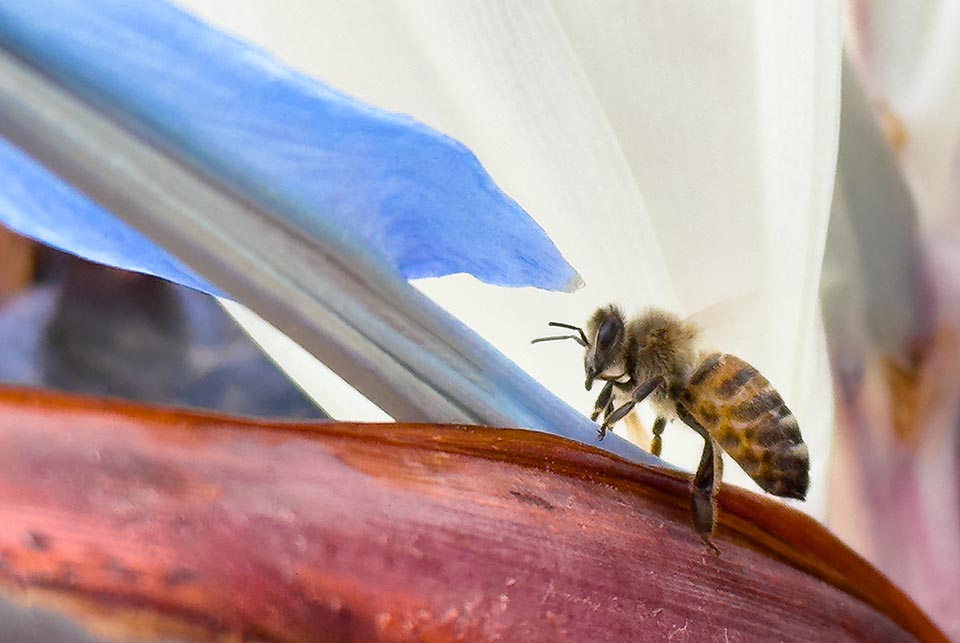
And naturally come also the bees, contributing, where are few nectarivorous birds, to the pollination of the plant © Giuseppe Mazza
The pollen, that is aggregated in filamentous sticky masses, then moves from the legs to the stigma of another flower, in a quantity sufficient already in only one visit, guaranteeing a sure fertilization. In this way every flower, even if visited only once, produces 12-18 seeds relatively big (0,3 g), that fill up the trilocular capsule. The high number of seeds produced in the studied area proves the effectiveness of the Nectariniid birds as pollinators. Also other visitors attracted by the nectar have been observed, but occasionally, such as the small galagid primates (Galagidae Gray, 1825), butterflies, ants and bees.
The insects do not always make contact with the pollen as they are unable to open the edges that enclose the anthers and also because while moving on the pollen and on the stigma, both sicky, they risk to remain attached to them. Where the pollinators are missing, in particular the birds, the quantity of vital seeds is very low because they form only thanks to the self-pollination.
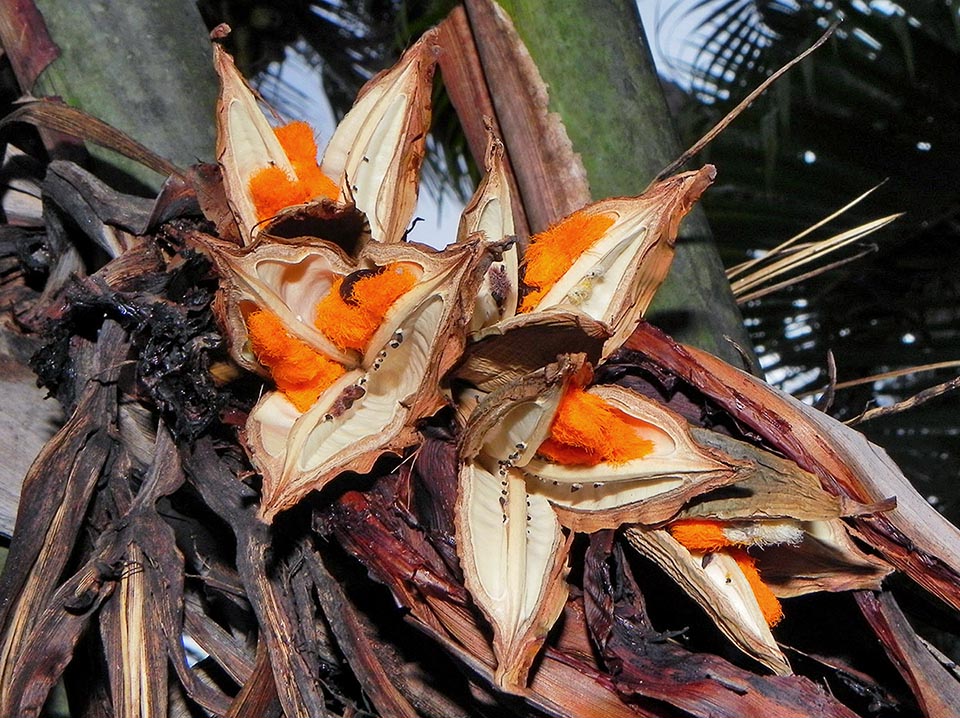
The seeds of Strelitzia nicolai, covered by a woolly bright orange aril rich in lipids, get form in autumn-winter © Henry Benoît
In autumn-winter the seeds get form, numerous, of black colour, with a woolly aril, rich in lipids, of bright orange colour. This colour contributes in attracting the birds who, eating the aril, facilitate the dispersion of the seeds. The dispersion of the seeds is done also by the Vervet monkey (Chlorocebus pygerythrus (F. Cuvier, 1821) and by the Samango monkey (Cercopithecus mitis albogularis (Sykes, 1831), primates feed on the soft parts of the flowers and of the aril.
Strelitzia nicolai is a very ornamental plant for its imposing posture as well as for the dense foliage. It is cultivated in open air in regions with mild climate and is sufficiently resistant to drought. In fact, it loves sunny expositions and fertile soil, well drained, but fears the cold.
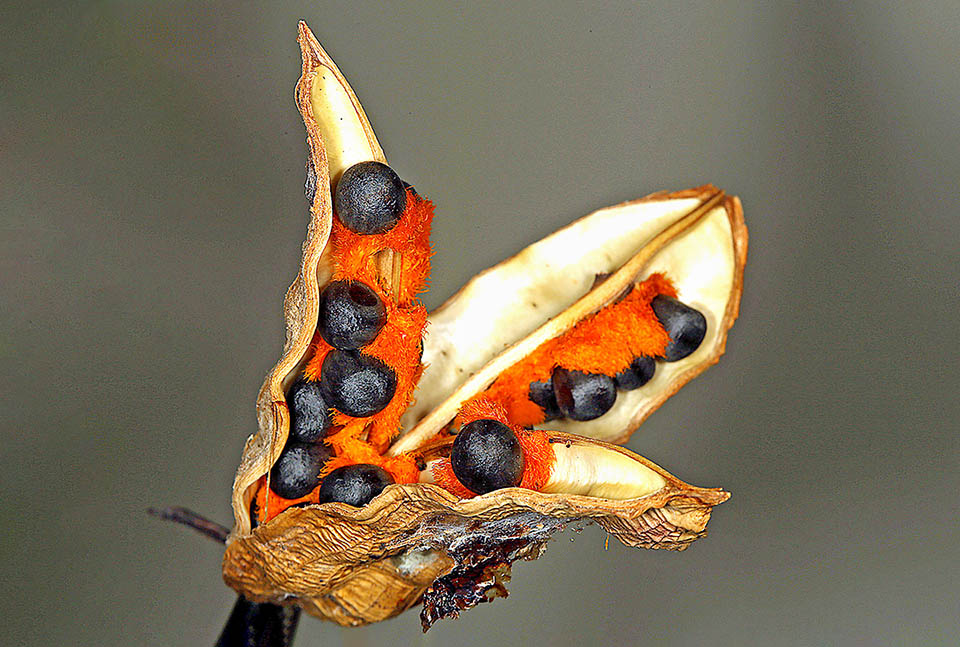
They are black fairly big and numerous with even 12-18 per each trilocular capsule, and are dispersed by monkeys and birds © César Garcia
It multiplies by seed or by division of suckers in spring. It’s a plant easy to cultivate, fairly resistant to parasites and requires little maintenance. At times it may be attacked by the floury or cottony cochineal that may be easily eliminated with the Neem oil, an insecticide of vegetable origin, or in the case of widespread infestations, with the white oil. The treatments are to be avoided in summer and consist in spraying the leaves in a way to create a thin patina able to trap and kill the parasites.
In the origin sites the natives utilize the dried leaf petioles to realize ropes, to build enclosures for the animals (kraal) and nets for the fishes.
The immature seeds are edible and have a good taste.
Synonyms: Strelitzia alba subsp. nicolai (Regel & Körn.) Maire & Weiller; Strelitzia quensonii Lem.
→ To appreciate the biodiversity within STRELITZIACEAE family please click here.
